
MiniStorm
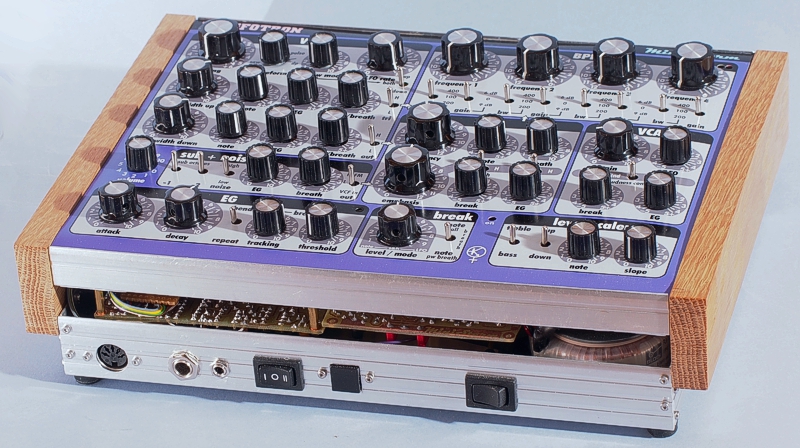
The MiniStorm almost completed and fully functional
This
synthesizer is specially designed to be used with a wind controller
and to produce single wind/brass instrument type sounds. With the
Berglund Instruments NuEVI you can control the synth with analog
control voltages. This avoids the drawbacks with a digital control
system, like MIDI.
I wanted to make this synth as small and
portable as possible but still include as many features as possible
that are useful for wind/brass instrument type sounds. It is slightly
smaller than an A4 page (but obviously thicker). As an afterthought,
it also has functions for playing plucked-type sounds and in that
mode the breath signal is replaced by key velocity.
The MiniStorm uses three AMORE modules. It's the Woodwind VCO, the Minimoog VCF/VCA mkII and the Wind VCAD (to be announced). Additionally, it has a small custom piggyback board and a power supply board (visible in the picture below). Apart from these boards, all circuitry is on the front panel board, where all pots and switches are soldered.

You
can tilt the front panel, like on a Minimoog. The panel can flip over
180 degrees. This gives access to the innards, for trimming, service
etc. By disconnecting a single connector and unscrewing one of the
sides, you can remove the front panel completely.
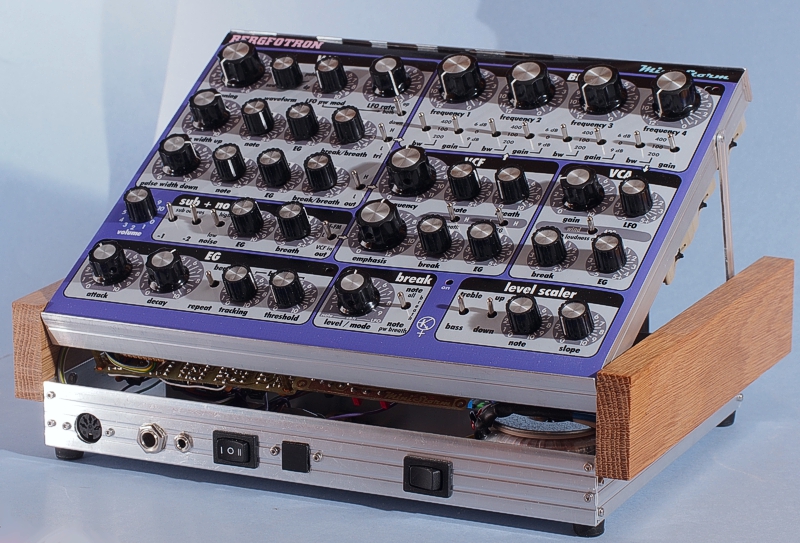
There
will be schematics, circuit board layouts, sound clips and more in
due course. These take time to do and aren't done yet.
In the
section below, we have look at the functions in detail.
Synth functions and features
The
MiniStorm has several functions you won't find on other synths. I
started by simulating the synth topology and functions on the Nord
Modular G2. This way, I could evaluate which features were useful and
which were not, without building and testing every idea in
hardware.
Instead of a block diagram, I include a render of the
front panel, which clearly indicates the synth structure. Then I
explain the functions module for module.
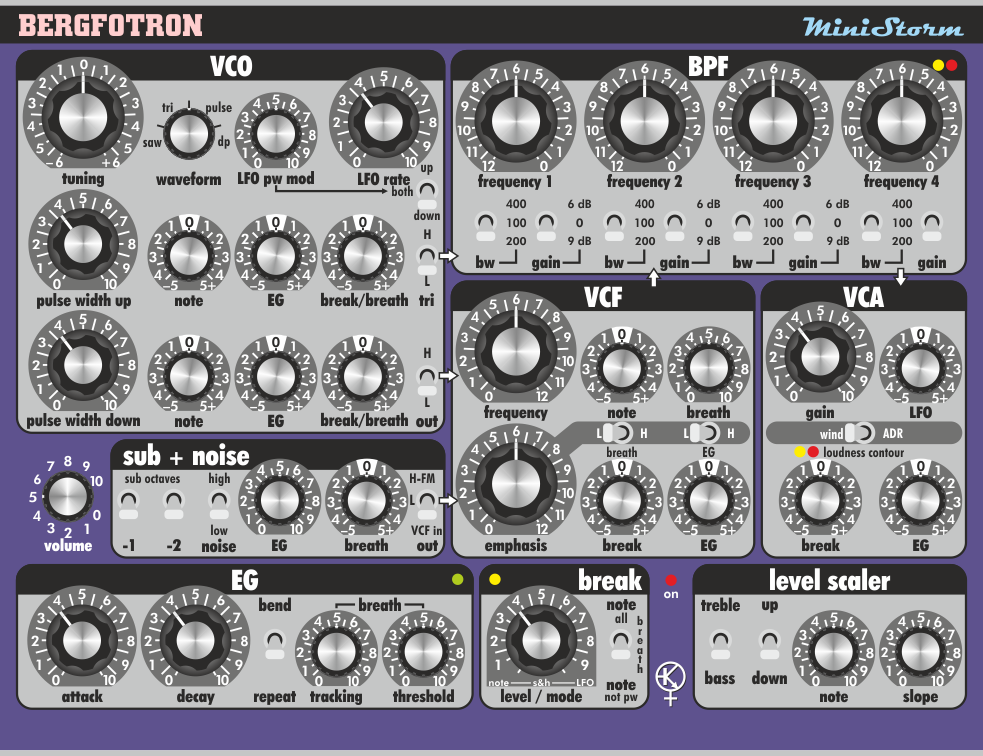
The
front panel
The modules
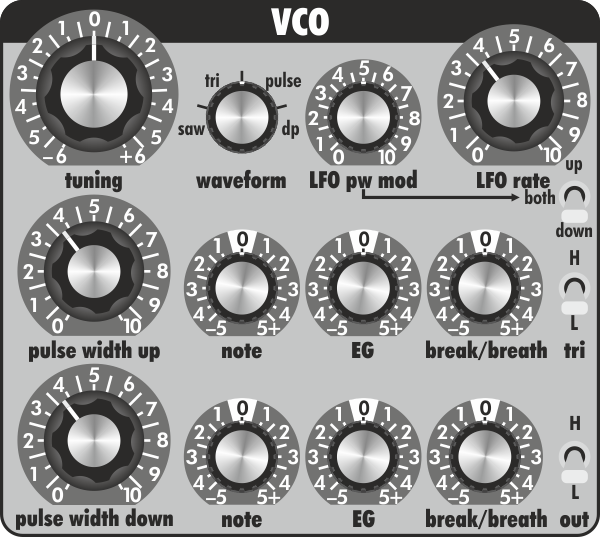
The
VCO
This
is the woodwind VCO of my own design. It is based on a core that is
similar to the Minimoog's. This has a very good tuning stability.
The
VCO offers sawtooth, variable triangle, pulse and double pulse. The
triangle has controls for pulse width up and down. These also control
the pulse waves. Note that the pulse widths don't change with the
VCO's frequency. This means that the width can be set to longer that
the wave period. For the up width, this causes the frequency to be
divided down.
A fixed pulse width will mimic the formants on wind
instruments. However, if you set note tracking to full (+5), the
pulse width will vary, to remain constant relative to the wave cycle.
Then it works (almost) like a traditional synth pulse wave.
The VCO has two outputs. Both has switches with off and two different volumes. The normal output is routed to the VCF and additionally, there is an output directly to the BPF for the variable triangle. This is in antiphase to the VCF output, so setting both to high volume will not necessarily result in a louder sound. The variable triangle output has a fixed 5 kHz 24 dB/oct lowpass filter to remove the buzz.
An LFO is integrated on the VCO module. It generates a triangle wave only. This can be routed to the up pulse width or down pulse width or both, with the toggle switch. In the latter case, the LFO is fed in antiphase to up and down pulse width, so when one increases, the other decreases. The LFO is also available at the VCA, for a tremolo effect. There is no control for LFO vibrato, since you're supposed to do vibrato manually on the wind controller. But there is a trimmer at the left panel edge that can add LFO vibrato. This can of course be substituted by a panel mounted pot, if you wnt.
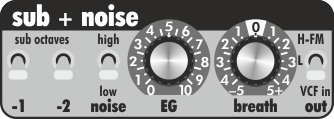
The
sub + noise
This module actually consists of several. It offers two suboctaves, derived from the VCO saw plus noise. You can select square waves one or two octaves down. If you select both, there will be a 25% duty rate pulse two octaves down. The noise has two levels plus off. The preset noise levels can be adjusted with trimmers at the edge of the board.
The noise and/or suboctaves are fed to a dedicated VCA which is controlled by the EG and/or breath pressure. The output of this VCA is sent to two fixed 24 dB/oct lowpass filters – one with 100 Hz and the other with 500 Hz cutoff. With the out-switch, you can select to send output from either filter to VCF FM or the signal (unfiltered) to the VCF input.
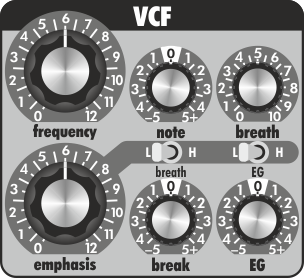
The
VCF
This is a Minimoog clone voltage controlled filter with 24 dB/oct lowpass output. Emphasis is Moog-speak for resonance. There are knobs for cutoff frequency modulation from note, breath pressure, break and EG. This means that you can mix these modulations anyway you want. The breath control has a special feature that makes the VCA open faster at higher settings. This gives a fuller sound when you sweep the filter with breath pressure. It however has a side effect in that the sound from the triangle output will reach full level at lower breath pressures with higher settings of the VCF breath control. This can be used for a sort of crossfading between the variable triangle and the VCF output. In ADR mode, the breath knob instead controls the amount of sweep from EG 2.
Since this filter has voltage controlled resonance, there is a possibility to modulate it. You have two switches with high and low settings for breath pressure and EG. With the high setting the filter will easily oscillate at the EG peak or when you blow hard.
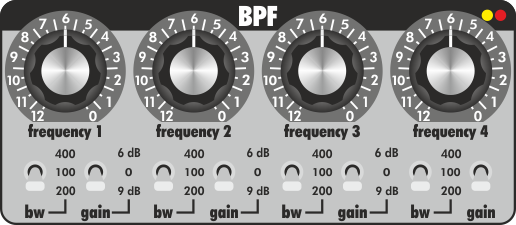
The
BPF
The
MiniStorm has no less than four bandpass filters. These are biquad
filters. This means that the bandwidth remains constant when you
adjust the frequency. You have 100, 200 and 400 Hz bandwidth to
choose from. The passband gain can me set to 6 dB, 9 dB or off. For
the 400 Hz wide setting, the gain are instead 3 dB and 6 dB. I found
this more useful. There is a signal strength indicator that lights
yellow at good signal and red at dangerously close to clipping.
The
center frequency of the filters can be adjusted between circa 270 and
6000 Hz with the knobs. The reason the controls go “backwards”
is that they use logarithmic pots and there are no reverse
logarithmic stereo pots for vertical mounting, as far as I know.
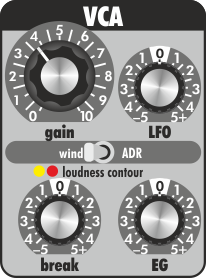
The
VCA
This
is a Minimoog clone VCA, which consists of two sections. The first is
controlled by the signal from the knobs. You have fixed gain plus
modulation from LFO, break and EG. The second is controlled by breath
pressure in wind mode and determines the level of the final output
from the synth. To be able to use the synth for bass and other
sounds, I added an ADR-mode, which is activated by the switch. Then
the output is controlled by a second envelope generator, instead of
breath pressure. This EG has settings for attack, decay and release
but no knobs on the front panel. There are connections for pots at
the edge of the circuit board. I use thumbwheel switches to set these
parameters but you could use trimmers or externally mounted pots
instead. The latter will of course make the synth larger.
There is
a signal strength indicator that lights yellow at good signal and red
at dangerously close to clipping.

The
EG
The envelope generator is my very special design. It's designed primarily to create attack transients. Therefore it has settings only for attack and decay. With the switch in the up position, the EG is routed inverted to VCO frequency. So the VCO will bend down with this function activated. You can adjust the amount of bend with a trimmer at the left panel edge or connect an external pot to make it easily adjustable.
The EG can also be used as an LFO with variable up and down rates, by switching it to repeat. In this mode you get a waveform that can continuously be varied from up saw through triangle to down saw. It will repeat as long as the gate is high.
Additionally, the EG has a threshold function. It will only trigger if you blow harder than the set level. At moderate to high settings it will only trigger when you tongue the notes. So if you start the note soft and then crescendo, it will not trigger.
Finally, there is a built-in VCA that lets breath pressure determine the EG amplitude more or less, depending on the tracking setting.
Since the EG is voltage controlled, you can modulate the attack and decay times. There are trimmers for note and breath tracking of attack and decay. These can be replaced by external panel-mount potentiometers if you wish.
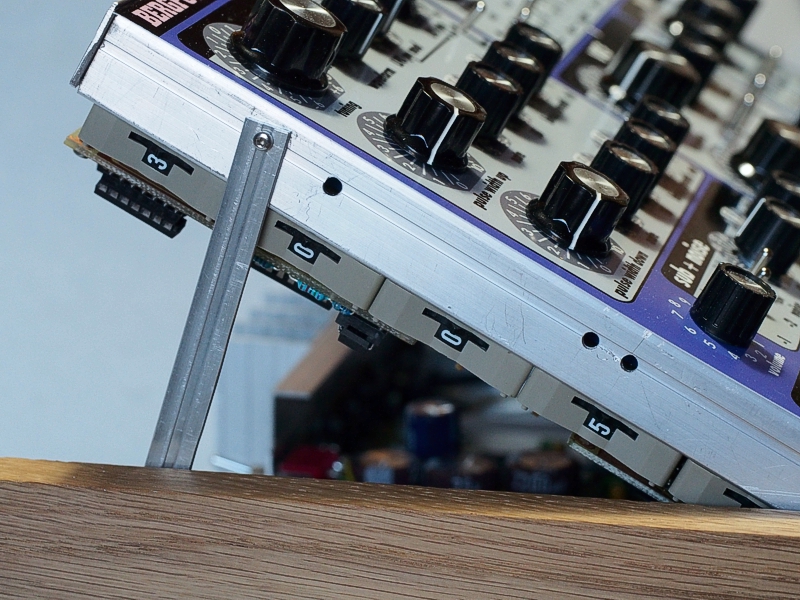
Thumbwheels
for adjusting autobend and breath and note tracking of attack and
decay. Note the small holes in the panel frame. That's where you
insert a screwdriver to trim VCO modulation by LFO and noise high and
low levels.
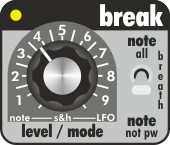
The
Break
This is a unique module of my own design. It is intended to simulate register breaks I wind instruments. As a matter of fact, it is necessary to prevent the variable triangle from dividing down when you play up the scale and want the pulse width to be constant. You set the break to the note where you want the break to occur. There is a yellow LED to indicate this. You set the break to note mode and adjust the break knob on pulse width up, to get the desired sound above the break. The break module's output jumps from 0 to 10 volts when the input exceeds the set level. It does this with a slew, so the jump will not create a pop in the sound.
The break module can also be used for breath pressure (switch in middle position). Then it will ho high above at set breath level. A third mode (switch down) is the same as note mode except that the pulse width knobs are fed with breath pressure voltage. Use this mode if you want to sweep the pulse width with breath pressure.
Since a break value of 0 or 10 isn't of any use, these settings are used to activate a sample and hold, instead of the break. At the 0 setting, the sample and hold triggers every note-on. This is useful if you want some parameter vary every note. At the 10 setting the S & H is triggered by the LFO. The usefulness of this can be debated but this module was carried over from the Transister project.
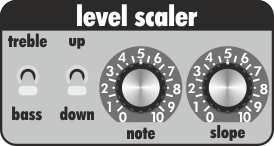
The
Level scaler
This module adjusts the loudness depending on the note played. You can set a breakpoint (note) and how much the loudness will increase or decrease above or below the breakpoint. This is for taming sounds that gets too loud or soft at one end of the note range. This module controls an extra VCA that is located between the BPF and the main VCA.
The ADR EG
On the front panel circuit board there is a simple ADR envelope generator. This is not used in wind mode. In ADR mode it controls the final VCA, like on a Minimoog and most other monosynths. In this mode, there is an extra VCA switched in between the Level scaler and the final VCA. This is controlled from a jack at the back. It is recommended to connect a velocity CV there. If the jack is left open, it is normaled to 10 volts, to make the MiniStorm work like a non-keyboard sensitive synth.
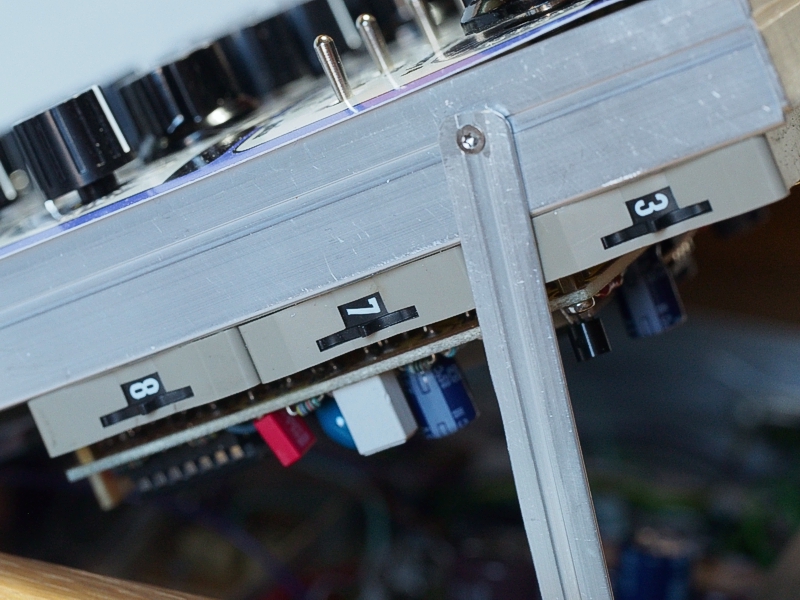
Thumbwheels
for adjusting attack, decay and release.
Connections

On
the back panel, there are connections for line out, external in and
CV in. There is also send and return for an external effects unit.
This enables you to hear the sound with effects in the earphones.
Further, it has a 9 volt output for powering the midi to CV converter
and a toggle switch for selecting CV from the front or back input.
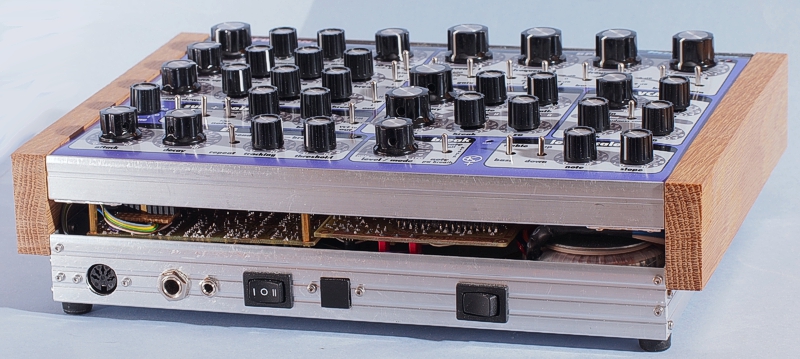
The
front has jacks for the wind controller and earphones (two types).
There is a switch that adds the breath CV to the pitch CV (two
strengths) for doing bends with breath. Further, a gate button for
triggering the EGs manually and a power switch.
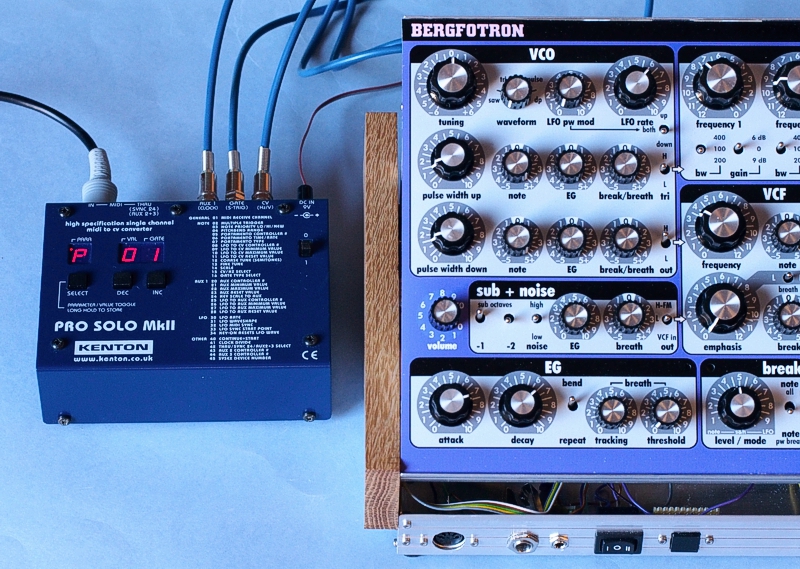
I
use a Kenton Pro
Solo midi to CV converter for playing the MiniStorm from my DAW.
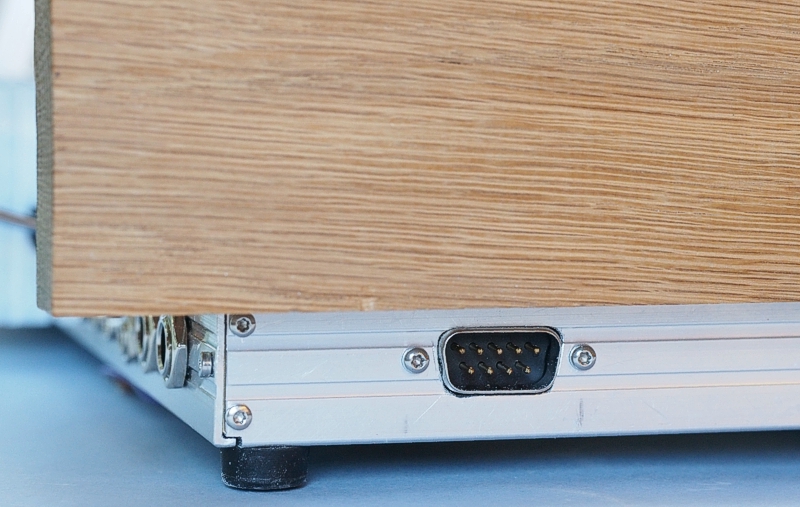
If
you want more possibilities than the MiniStorm offers, you can
connect an expander to this jack. It offers power and CV out plus an
audio connection that goes to the VCF input. All you need for adding
extra VCOs, for instance. There also is an audio output, if you want
to add a module with further sound processing.
What's in the box
The MiniStorm contains the following modules:
1
VCO with sawtooth, variable triangle, pulse and double pulse
1
suboctave generator
1 noise generator
1 VCF ladder type, 24
dB/octave lowpass
5 VCA
4 variable bandpass filters
4 fixed
24 db/oct lowpass filters
1 LFO
1 VCAD envelope generator
1
ADR envelope generator
1 Break generator
1 Sample and hold
1
Level scaler
It
has switches for all signal routing, replacing patch cords.
Building
a Eurorack system with the above features would require much more
space and would be much slower to create patches on.
Sound clips